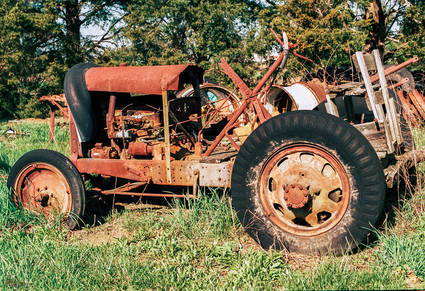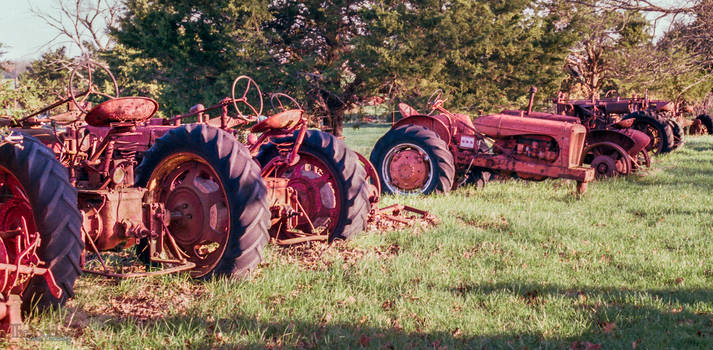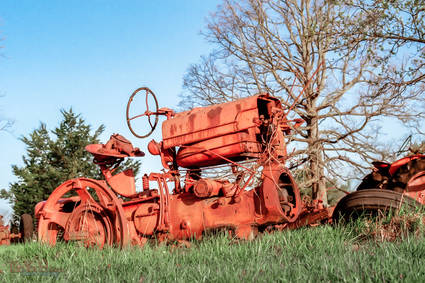Where Do Tractors Go?
On American farms, the most important innovation of the last century is the tractor. From its introduction as a steam-powered behemoth, the tractor enabled a farmer to accomplish more work with less labor. The farmer was able to till and harvest larger sections of land. Tractors are versatile too! There are all kinds of attachments that can transform a tractor so it can be used to drill holes for fence posts, muck out the barn, or any of dozens of chores around the farm. The tractor soon became an indispensable helper that allowed the farmer to finish the innumerable chores about the farm more quickly. What this really meant was that more chores could be added to a list that already seemed endless. In the business world such a thing is known as "increased productivity." Such improved efficiency in an industry already so lucrative as farming promised even greater profits which could then be spent on... yes, more farm equipment and higher bank payments, which leads to in even greater efficiency. This is easily proven by counting the many retired farmers that live in penthouses on Fifth Avenue.

Like everything, tractors, too, have their allotment of time on this earth. Constructed of iron and steel, tractors persevere long after their useful working life has ended. At some point each one sees the day when the farmer decides he no longer needs it. Perhaps it has broken down from wear, misuse or accident; or, though still functional, has been deemed no longer needed around the farm. The idled tractors are often retired to out-of-the-way pastures or wood lots to battle the seasons in their slow, patient manner. The ultimate stoics, they stand mute through the years, their once-bright paint fading, rust consuming their manifolds and exhaust pipes.

Not all tractors are destined to rust away in isolation. Just as there are junk yards for automobiles the same is true for tractors. Throughout the American Midwest there are men who scour the countryside scouting for old equipment. They attend farm sales, equipment auctions and drive down rural roads looking for old, disused "junk". Their day is made when they look across a pasture and see in a wooded lot, a place where a farmer has been parking his old equipment for years. Once he has made the initial discovery, he has to uncover who owns the land where the cache is stored. Then the work really begins. He has to persuade the farmer to part with the equipment. This can be tricky. The first tact is often one of esthetics. "Golly, that pasture would probably look a whole lot prettier without all of that junk in there...." Of course someone showing interest in what the farmer had thought of for years as useless junk will suddenly make the hulks more precious and sentimental bonds grow quickly. I have heard tales of one shrewd buyer making a deal to buy the trees out of a woodlot "for lumber" and then offering to "haul the junk off for free."

When the deal has been made, the buyer then has to figure out how to get the equipment out. Places where old tractors have been mothballed are often used for such a purpose because they are difficult to reach and out of the way. If equipment has been sitting in one spot for years, trees may have grown close around or even through the machines requiring the surgical use of a chain saw before the tractor can be removed.

Richard Silva is a tractor guy. For forty years he has been working the Northwest portion of the Ozark Mountains convincing old timers to let go of their treasures. On his land there are hundreds of pieces of farm equipment of all types, sizes and condition You won't find the latest John Deere Harvester amongst his accumulation, but you might find a 1947-52 Case tractor or a 1939 FarmAll. Plows, cultivators, manure spreaders, even some horse equipment are some of the things you can find here. Heck, he even has a pitchfork if you want to put your back into a job. Do you need a crank shaft for an old Ford tractor? Richard probably has three and will be happy to sell you one of them.
A small man, Richard's face is imprinted with the lines of innumerable smiles that he has bestowed upon others. His vigor belies his 78 years. Without a second thought he will be on his back crawling under a tractor, wrench in hand, to investigate a strange noise or odd behavior. One concession he has made to his age is that his new equipment acquisitions are brought in to the front 40 acres of his farm instead of the section behind that. "When I turned 70," he will say with a smile and a soft chuckle, "I realized the advantages of working closer to the supper table."
If you spend any time at Richard's, you will find a trickle of farmers and tractor aficionados stopping by. Each new person is greeted with a robust "Hello, old friend, how are you doing?" He has a lot of "Old friends", but don't make the mistake of thinking he uses a generic greeting because he doesn't remember you. He might not remember a person's name from first, hasty introductions, but he knows every piece of equipment they've bought. I wouldn't be surprised if he had a complete inventory of every piece of equipment he ever bought and sold stored up in his head.

I was over at Richard's when a farmer in distress pulled up in a cloud of dust. It was apparent he was in great haste by the fact that he only spent 15 or 20 minutes in greetings and gossip before heading into the back lot with a hammer, a crescent wrench and a vise grips. He knew exactly what he wanted and where to find it. In another 20 minutes he came back, a little grimier, with the part from a 40-year-old hay baler that would allow him to finish his work.

"Richard," He said, "I should buy that whole baler from you. Seems every season I am running over here pulling parts from it."

"Well," Richard replied in his soft voice, "I don't mind selling it to you one piece at a time either. This way is easier on your back."

A tractor junk yard is a great, iron organ bank. Collectors, restorers, and working farmers all show up for that essential part that finishes the project or lets the harvest be completed. The dissection of some of the machines has been quite thorough. All that remains is the frame and some wheels. Sometimes the transmission housing is still bolted onto the frame, it's complexity of gears transplanted into another tractor to keep that one going for another decade.

Slowly, the tractors are reduced to their basic components. Usable parts are removed as needed. Sometimes, when unneeded pieces are removed to get to a part deeper inside, the excess parts are moved to a similar model. You will see a tractor with three hoods or a pile of matching lamps on the seat... a farmer's inventory database management system.... Over the years, as the wrenches and bruised knuckles have done their work, the tractors undergo yet another transformation. Rust covers the exposed metal. If it is resting under a tree, moss and lichen will grow, creating a lovely patina, rich with greens and browns. They lose their original identity as a tractor or whatever they might have been. New shapes and forms emerge as the weathering takes place, as parts are removed and pieces of other equipment are piled against the first. You can walk through the rows of equipment identifying pieces & parts, brands & dates, or you can let your mind wander into the realm of pure form & imagination, seeing shapes and colors... abstract, yet familiar. Like laying on your back and watching the clouds gliding past in the summer sky.... Seeing the shapes of horses, creatures and familiar faces. Amongst the hulks of the tractor graveyard, what you discover is limited only by your imagination.

This article was first published in 2001. In 2006 it was translated into German and published in a magazine over there. I took a lot of pictures over at Richard's place. So for all of you lovers of old beaten-up tractors & such I will include extras here.












 Where Do Tractors Go?
Where Do Tractors Go?